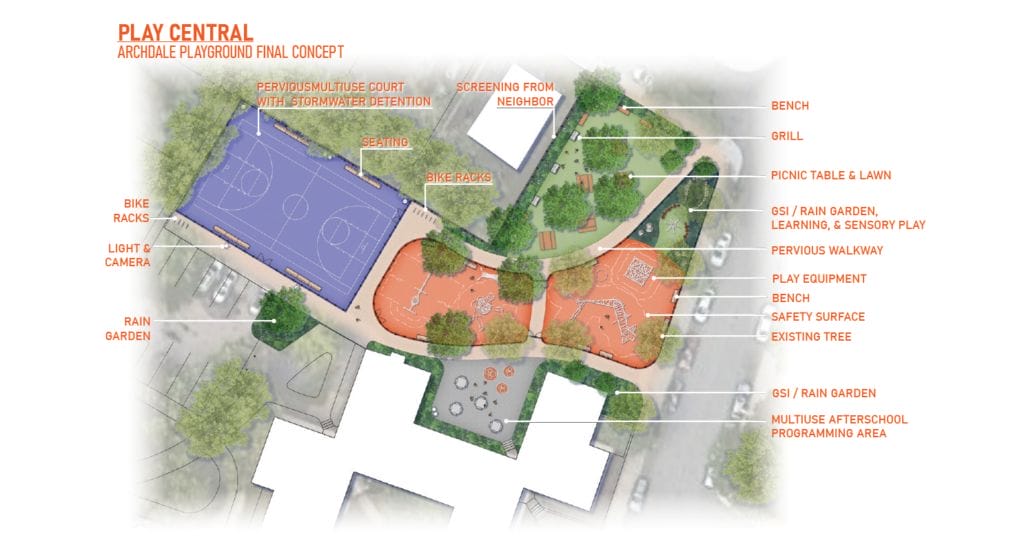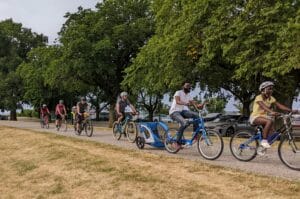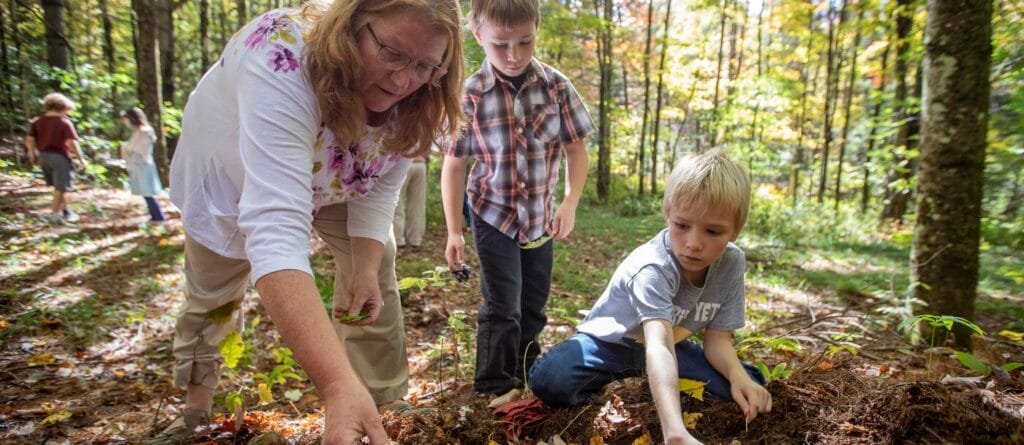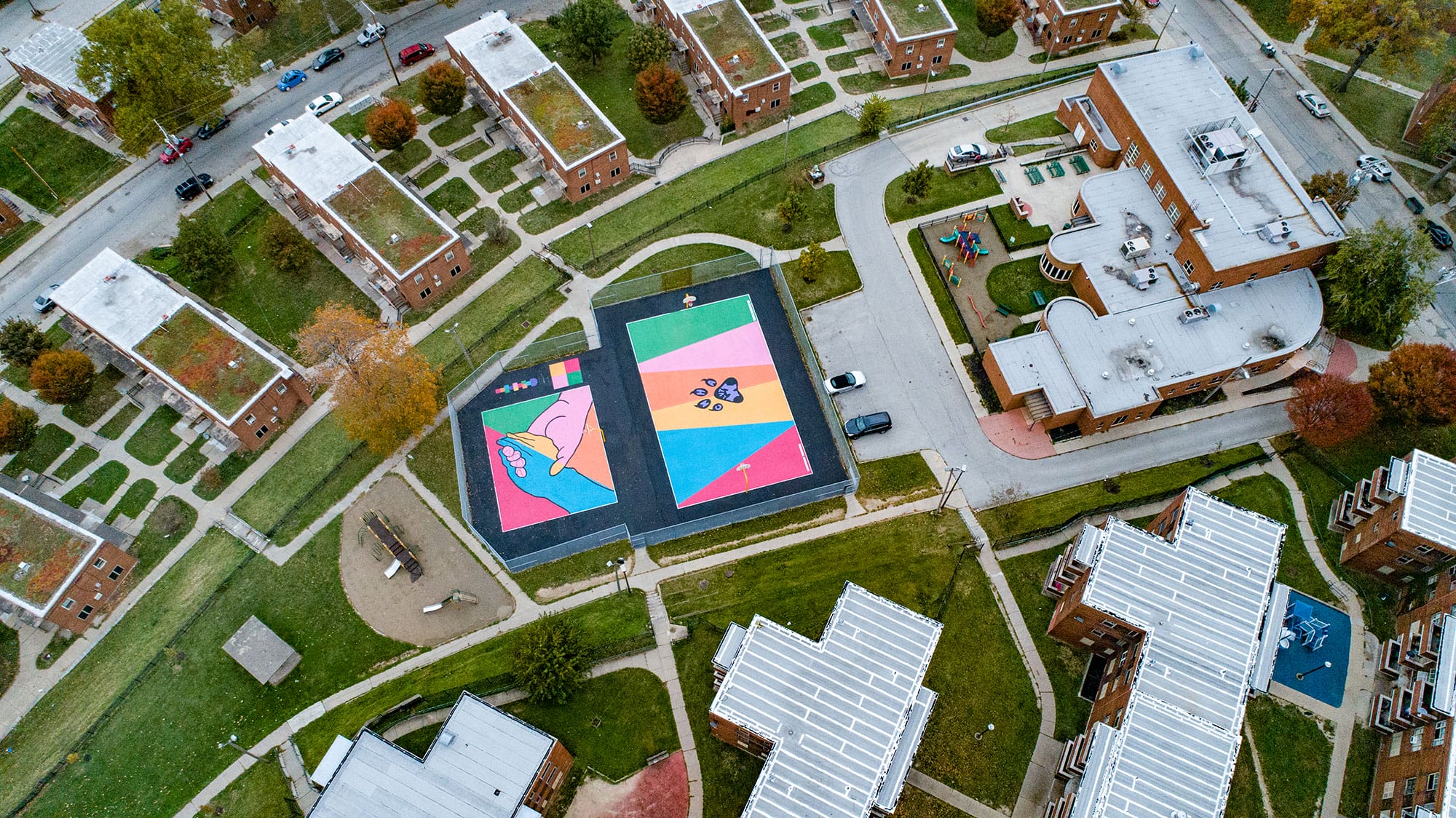At Archdale Village, a public housing development in Boston, residents can practically see Harvard University’s famed Arnold Arboretum in the near distance. The nature preserve, designed by Central Park architect Frederick Law Olmsted, is only two blocks from Archdale, but it might as well be a world away given the train tracks that separate the two sites. Making matters worse is the fact that a playground that burned to the ground at Archdale several years ago was never replaced.
Enter Trust for Public Land. For the two intervening years, we’ve worked with the Boston Housing Authority to engage hundreds of residents at Archdale on plans for a major renovation of the outdoor space there. During three separate meetings, TPL staff, along with a nonprofit design firm we enlisted, coaxed ideas from residents for the green space, now mostly an empty expanse of patchy grass.

Conceptual renderings by COGdesign of the proposed outdoor space at Archdale Village in Boston.
Plans call for a new basketball court and an up-to-the-minute playground, including climbing structures and a sensory play area. To capture stormwater and prevent flooding at the 281-unit complex, the space will include rain gardens while the basketball court will let rainwater soak through. Bicycle racks, benches, outdoor grills, game tables, native plants, and additional lighting will make the grounds welcoming to all ages. “It’s going to mean a lot,” says Sabrina Ivory, 66, an Archdale Village tenant since 1977 and a community leader. “It’s not attractive right now. This will give families a place to go and create excitement.”
Boston is only the most recent place where Trust for Public has collaborated with public housing agencies and providers of affordable housing. It is a venue that holds tremendous potential for connecting everyone to the outdoors. The reason is plain: many subsidized housing complexes around the country may have outdoor space, but it is often drab and devoid of amenities. Other hurdles prevent residents from accessing actual parks, ranging from the lack of convenient transportation to physical (and sometimes psychological) barriers that stem from the scourges of systemic racism and segregation.
“Most housing authorities require income caps for Section 8 assistance that is designed to help low-income families secure safe and affordable homes, ” says Sean Terry, TPL’s state director in Ohio. He adds that, per statue, rents are generally set at 30 percent of the household’s adjusted monthly income. “Most people who live in the Lakeview units are at a threshold that’s less than Cleveland’s median income, which is roughly $33,000. So there’s an inherent equity focus that the housing agencies are built around. For us, the collaboration makes total sense.”
 In Cleveland, TPL partnered with the Cuyahoga Metropolitan Housing Authority at Lakeview Terrace, one of the oldest public housing developments in the United States. Built in the 1930s, the 19-story building at Lakeview Terrace is surrounded by grounds that reflect a time when green space and recreation weren’t a public priority.
In Cleveland, TPL partnered with the Cuyahoga Metropolitan Housing Authority at Lakeview Terrace, one of the oldest public housing developments in the United States. Built in the 1930s, the 19-story building at Lakeview Terrace is surrounded by grounds that reflect a time when green space and recreation weren’t a public priority.
Home to a multigenerational population of 3,000 residents, Lakeview lacked safe, inviting outdoor spaces to gather, play, and celebrate with neighbors. Trust for Public Land teamed up with L.L.Bean, which donated $1 million to the project, and worked with the housing authority and residents to transform the grounds into a place where people now want to linger.

Residents of Lakeview Terrace in Cleveland chip in to paint the newly renovated playground and basketball courts. Photo: Joshua Dobay
Over the course of a year, residents worked with artists, landscape architects, and environmentalists on the space. In 2018, we oversaw the installation of new basketball courts, which now boast bold, colorful murals on the playing surface. We also planted dozens of trees on the 78-acre property.
 In June 2022, TPL and Bike Cleveland, an advocacy group, held a “bike jam” at Lakeview Terrace. The event was a chance to raise awareness about the nearby Centennial Lake Link Trail and newly established access to the lakefront via Wendy Park Bridge, whose creation we also supported. In addition to a guided ride of the new trail network, Lakeview residents were treated to a pop-up bike repair shop that offered free services, while 30 bicycles were raffled off and additional safety gear like helmets and lights were given away. Other partners for the event included Ohio City Inc., Joy Machines Bike Shop, and Cargill.
In June 2022, TPL and Bike Cleveland, an advocacy group, held a “bike jam” at Lakeview Terrace. The event was a chance to raise awareness about the nearby Centennial Lake Link Trail and newly established access to the lakefront via Wendy Park Bridge, whose creation we also supported. In addition to a guided ride of the new trail network, Lakeview residents were treated to a pop-up bike repair shop that offered free services, while 30 bicycles were raffled off and additional safety gear like helmets and lights were given away. Other partners for the event included Ohio City Inc., Joy Machines Bike Shop, and Cargill.
“In Cleveland, like elsewhere, there’s not a lot of green space built right into the campus; nor are their connections to green spaces because of historical red-lining and physical barriers,” explains Terry, referring to the lending practice in the 1930s when banks shunned communities of color. “So this makes for a strong complement, a validation of why partnering with organizations like ours is important.”
In more rural parts of the country, where we typically pursue large-scale conservation projects involving hundreds (even thousands) of acres, we are setting aside land for new affordable housing if the project is close to jobs, a school, and transportation. The number of potential units may be small, but coupled with other efforts, this represents a critical step in helping teachers, police officers, restaurant workers, and others who find themselves priced out of the local housing market.
At Wolcott Community Forest in Vermont, for example, TPL is undertaking a project with the twin goals of protecting land and laying the groundwork for affordable housing. As part of the creation of the 734-acre community forest, TPL will donate two acres to Lamoille County Habitat for Humanity, who will build a duplex there. This will provide two families at or below 80 percent of the median income for the county with an affordable place to live near an elementary school and a community forest. The homes will remain affordable in perpetuity through a covenant in the deed, says Kate Wanner, senior project manager for TPL in Vermont.

The Wolcott Community Forest is primarily used for hunting, fishing, hiking, mountain biking, and bird watching. Children and classes frequent the area since it’s adjacent to Wolcott Elementary School. Photo: Chris Bennett
An hour and a half south in Hanover, New Hampshire, TPL worked with residents to create a new community forest with workforce housing folded into the plan. Mink Brook Community Forest, which is managed for sustainable timber harvesting and flood resilience, covers 253 acres; a nearby 5-acre parcel was set aside for residents who are thwarted in their search for housing in a town with a median home price of over $1 million. TPL donated the land to the Town of Hanover, and the property is slated for a cluster of cottage-style houses.
But it is our work in cities that perhaps holds the most promise for connecting large numbers of residents to attractive green spaces. In Boston, for instance, the Housing Authority oversees 68 public housing developments, and the agency has launched a “Sustainability Strategy” to both reduce carbon emissions and make properties more climate resilient.
The work at Archdale Village could be the start of a fruitful partnership, one that aligns with the city’s sustainability goals and gives public-housing residents healthful outdoor places in which to recreate. “Boston Housing Authority has many properties, so if this pilot goes well, we’d like to use this as a model throughout the city,” said Jodi Valenta, TPL’s Massachusetts state program director. “We want to make this work.”
Dana Dilworth, a senior project manager in planning and real estate development for the Boston Housing Authority, agreed. He pointed out that the authority’s properties ranged from a single-family home to an 1,100-unit complex, and the city serves 25,000 residents with public housing.
“Our bottom line is we would like to get people outside and active,” Dilworth says. “The only thing holding us back is staffing and resources. Trust for Public Land has a depth of knowledge and has been very responsive.”
Lisa W. Foderaro is a senior writer and researcher for Trust for Public Land. Previously, she was a reporter for the New York Times, where she covered parks and the environment.
One-third of Americans, including 28 million children, lack safe, easy access to a park within a 10-minute walk of home. Urge your senators to allocate funding to create parks and enhance outdoor recreational opportunities by championing the Outdoors for All Act today!

Donate to become a member, and you’ll receive a subscription to Land&People magazine, our biannual publication featuring exclusive, inspiring stories about our work connecting everyone to the outdoors.

